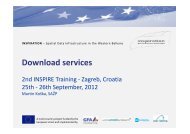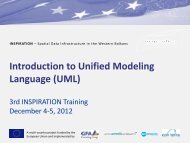MOVE - Moderation and Visualization for Group ... - INSPIRATION
MOVE - Moderation and Visualization for Group ... - INSPIRATION
MOVE - Moderation and Visualization for Group ... - INSPIRATION
Create successful ePaper yourself
Turn your PDF publications into a flip-book with our unique Google optimized e-Paper software.
Difficul t situatio<br />
n…<br />
…<strong>and</strong><br />
how<br />
to<br />
h<strong>and</strong>le<br />
it<br />
A few<br />
participants<br />
monopolize<br />
discussions<br />
A participant<br />
goes<br />
off<br />
on<br />
a<br />
lengthy<br />
tangent<br />
unrelated<br />
to<br />
the<br />
current<br />
discussion<br />
Some<br />
participants<br />
continually<br />
hold<br />
private<br />
conversations<br />
A participant<br />
expresses<br />
disagreement<br />
with<br />
what<br />
the<br />
moderator<br />
says<br />
Some<br />
participants<br />
do<br />
not<br />
take<br />
part<br />
at<br />
all<br />
during<br />
discussions<br />
The The group group life life cycle<br />
cycle<br />
Working in small groups offers one of the most<br />
promising environments <strong>for</strong> overcoming<br />
‘difficult situations.’ Ringleaders <strong>and</strong> experts<br />
have a limited chance to st<strong>and</strong> out, shy participants<br />
dare to express themselves in<strong>for</strong>mally, <strong>and</strong><br />
social pressure gets laid-back persons to work.<br />
Participants quickly learn about each others’<br />
strengths <strong>and</strong> weaknesses. Also, they will develop<br />
a mode to balance those characteristics, underst<strong>and</strong>ing<br />
soon that a group is more than the sum<br />
of its individual members. Still, as the moderator,<br />
you should always observe the emotional<br />
state of the group, its social relationships, <strong>and</strong><br />
group dynamics. There are typical stages in the<br />
group learning process:<br />
Forming. orming. orming. The group is still a set of individuals<br />
trying to establish an identity from within,<br />
<strong>and</strong> the members are still familiarizing<br />
themselves with one another. The members<br />
start focusing on a task at h<strong>and</strong> <strong>and</strong> its<br />
purpose. The group develops essential rules<br />
<strong>for</strong> future decisions <strong>and</strong> actions.<br />
46<br />
Summarize<br />
the<br />
participants'<br />
viewpoints,<br />
then<br />
move<br />
on.<br />
Ask<br />
others<br />
<strong>for</strong><br />
their<br />
inputs.<br />
Ask<br />
the<br />
participants<br />
to<br />
hold<br />
off<br />
until<br />
a<br />
break.<br />
Ask<br />
the<br />
participant<br />
to<br />
hold<br />
off<br />
until<br />
later<br />
in<br />
the<br />
event.<br />
Summarize<br />
the<br />
participant's<br />
viewpoint<br />
<strong>and</strong><br />
move<br />
on.<br />
Address<br />
directly<br />
that<br />
a<br />
tangent<br />
has<br />
been<br />
raised<br />
<strong>and</strong><br />
restate<br />
the<br />
purpose<br />
of<br />
the<br />
discussion.<br />
Use<br />
non-verbal<br />
methods<br />
to<br />
regain<br />
the<br />
participants'<br />
attention<br />
through<br />
eye<br />
contact,<br />
move<br />
closer.<br />
Ask<br />
one<br />
of<br />
them<br />
a question,<br />
using<br />
the<br />
participant's<br />
name.<br />
Ask<br />
them<br />
to<br />
refrain<br />
from<br />
talking,<br />
privately,<br />
if<br />
possible.<br />
Summarize<br />
the<br />
participant's<br />
viewpoint.<br />
Ask<br />
others<br />
<strong>for</strong><br />
their<br />
opinion.<br />
Agree<br />
to<br />
disagree.<br />
Agree<br />
in<br />
part,<br />
then<br />
state<br />
how<br />
you<br />
differ<br />
<strong>and</strong><br />
why.<br />
Use<br />
non-verbal<br />
means<br />
to<br />
draw<br />
the<br />
participants<br />
into<br />
the<br />
discussion.<br />
Ask<br />
direct<br />
but<br />
non-threatening<br />
questions.<br />
Connect<br />
with<br />
the<br />
participants<br />
during<br />
breaks.<br />
adapted from: DSE-ZEL: Training Manual “Training of Trainers <strong>for</strong> Rural Development”, Feldafing 2001, Module 3, p. 22<br />
Storming. Storming. Intra-group conflict prevails while<br />
established rules are violated. Individuals<br />
often pursue personal agendas, causing<br />
frictions within the group to increase. Conflict<br />
resolution leads to a more realistic setting of<br />
objectives, procedures <strong>and</strong> norms.<br />
Norming. Norming. Tensions are overcome <strong>and</strong> group<br />
cohesion grows. <strong>Group</strong> members accept each<br />
individual’s peculiarities, causing a group<br />
spirit to emerge. Harmony becomes one of its<br />
key features.<br />
Per<strong>for</strong>ming. er<strong>for</strong>ming. Roles become more differentiated<br />
<strong>and</strong> functional, as members collectively<br />
pursue group objectives. The group’s<br />
energy is directed at identified tasks.<br />
Maximum productivity is reached, so that<br />
new insights <strong>and</strong> solutions begin to emerge<br />
(see H<strong>and</strong>y 1985)<br />
But you should be aware that this process varies<br />
greatly depending on the socio-cultural backgrounds<br />
of the group members. There<strong>for</strong>e, there<br />
is no blueprint <strong>for</strong> suitable interventions.
















